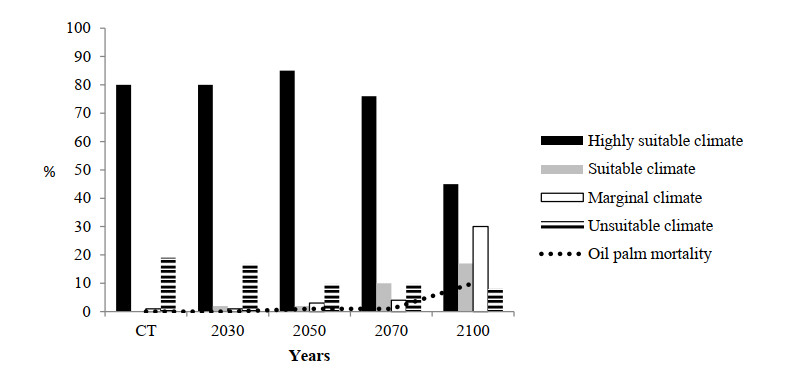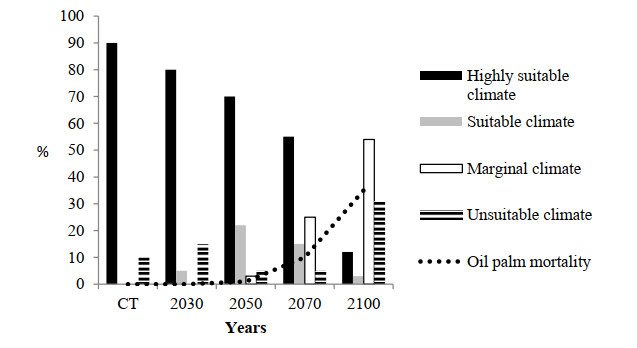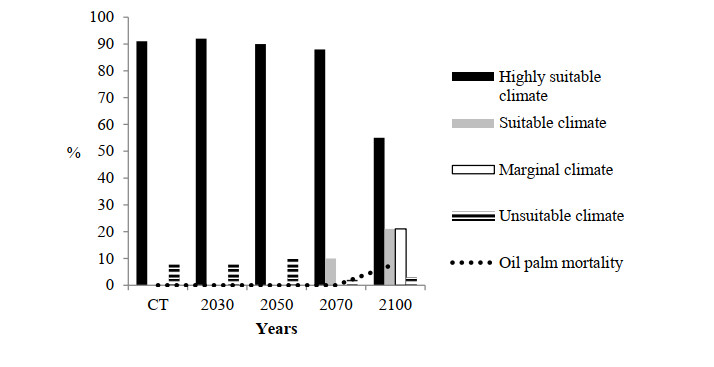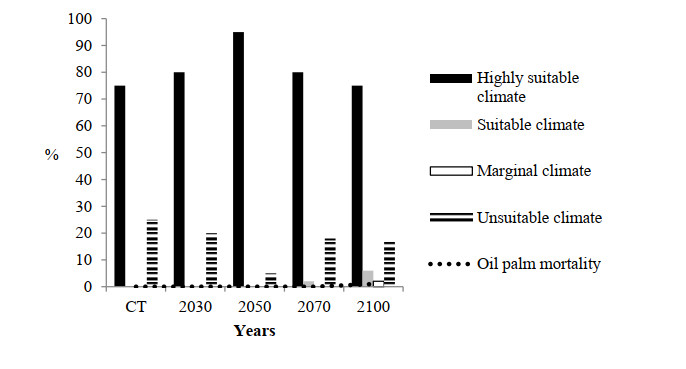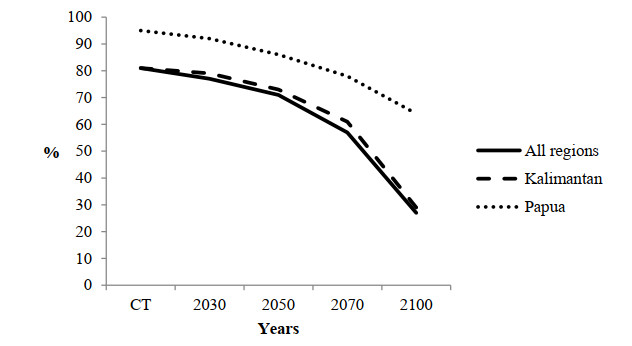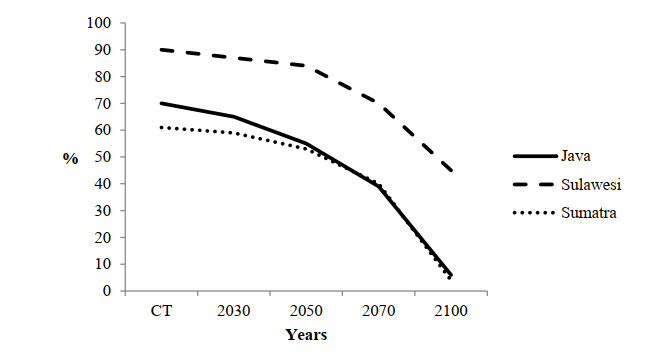Currently there are increasing land-cover change and land-management issues related to oil palm plantations. Palm oil is highly valuable and it is added to numerous commodities internationally with Indonesia being the most voluminous producer. The cultivation of oil palm affects the environment negatively, per se, threatening plantation sustainability from deforestation. Furthermore, the fungus Ganoderma boninense causes basal stem rot of oil palm, a major problem for plantation managers in Indonesia. Suitable future climate for growth of Indonesian oil palm, determined by employing the simulation programme, CLIMEX, has already been employed to create scenarios of oil palm mortality and diseases. This was achieved by combining CLIMEX with narrative models, a technique often employed in climate studies. Determinations of the percentage of oil palm that survive climate change and do not have basal stem rot have also been provided. The current paper considers these scenarios for Indonesia and regions for the first time. The models assume "no change" in the future climate scenarios and that effective mitigation is not taken. The effects on plantation sustainability are considered. Climate change will not affect the incidence of basal stem rot greatly until 2050, but the situation will deteriorate thereafter. Sumatra and Java are especially affected and plantations may be unsustainable quickly, whereas Papua and Sulawesi may be able to sustain the crop longer. However, deforestation in Papua and Sulawesi is highly undesirable. Methods to manage climate change effects on oil palm and reduce basal stem rot are described. Plantation managers can use the earlier assessments herein to indicate if the later ones are accurate and plan to ameliorate the problems. Conclusions indicate that palm oil production may be unsustainable in Indonesia by 2050 from loss of plantations thus requiring action immediately.
1.
Introduction
There are increasing land-cover change and associated land-management issues in relation to oil palm plantations [1]. Demand for palm oil has transformed these landscapes in numerous ways including by highly increased deforestation compared to the previous century. There is increasing information on how 21st-century climate change is likely to decrease the sustainability of plantations with serious implications for food security, biodiversity loss and the economies of palm oil producing, and other countries, that use the oil in numerous commodities [2,3,4,5,6].
Palm oil is very important [7]. The commodity is employed (i) in cooking, (ii) in food and cosmetics, (iii) as detergent, (iv) in plastics, (v) as chemicals and (vi) as biodiesel [1]. Indonesia’s economy is supported by high financial returns from palm oil and it accounts for more than 30% of global demand for vegetable oil. Current global production indicates that 61% comes from Indonesia [8] which is the world’s largest manufacturer. Lam et al. [8] indicate that most Indonesian oil palm are located in Sumatra and Kalimantan and that the greatest potential for developing new plantations are in Sulawesi and Papua, although it is essential to preserve the natural forest for environmental reasons. In 2009, 65, 25 and 3% of plantations were located in Sumatra, Kalimantan and Sulawesi respectively with the remainder being loosely distributed over other regions including Papua and Java [9].
Oil palm cultivation increased from 10 to 17 million ha between 2000 and 2012 which was expected to increase [8]. Paterson et al. [10,11] indicated that climate change will affect oil palm production severely, especially after 2050 and production may not increase, at least by as much that is anticipated [8]. Oil palm production may decrease from 10 to 41% if temperature rises from 1 to 4 ℃ [6]. In addition, basal stem rot of oil palm, a serious disease caused by the fungus Ganoderma boninense, is likely to increase, making the industry much less sustainable in South East Asia [2,3,4,5].
Oil palm is associated with deforestation and conversion of peat soils, inevitably involved in climate change and haze creation: The negative effects on biodiversity are concerning [12], although even greater deforestation may occur with other oil crops [13]. However, palm oil may have a higher greenhouse gas footprint [8]. Climate change affects detrimentally oil palm agronomy potentially leading to low sustainability [1,2,3,4,5], whereas a lowered ability to grow oil palm may reduce climate change because less greenhouse gas will be produced. Palm oil is one of the highest causes of greenhouse gas currently from global land use and cover change [8]. The effect on human health from consuming palm oil and growing oil palm is also of concern, adding to the commodity’s general importance [14]. Zoonotic disease in humans may increase from conversion of natural forest to agriculture crops [15] and changes in the ability to grow oil palm will affect deforestation. The effect of climate change on oil palm agronomy requires greater understanding, although there is much information on the effect of palm oil agronomy on climate change. Climate change effects on oil palm is relevant to the sustainability of the industry through risks to plantations, with economic and social implications [1]. All stakeholders will be affected, e.g. oil palm companies, food manufacturers, smallholders, cosmetic manufactures and biodiesel producers and consumers. There are three areas where a decline in oil palm production could occur: (a) concerns about biodiversity and increased greenhouse gases, (b) climate change [10,11] and (c) health concerns of palm oil [14,15].
Southeast Asia is predicted to face the highest loss in crop production with the rise of temperature. Oil palm fruit production has declined due to the uncertainties of climate change and it has estimated to have significant nonlinear impacts on the net revenue of oil palm production. The land for oil palm production can become dry and degraded, and oil palm plantations may become susceptible to diseases and pests due to temperature rise [6].
Indeed, oil palm is threatened by various diseases [7] and many fungal ailments are anticipated to become more prevalent as climate change progresses [6]. Pathogens live in a dynamic environment with the host where the disease may take hold if the plant becomes less resistant. Basal stem rot by Ganoderma boninense has been prevalent for 80 years [7] and is the most serious disease in S E Asia. The level of disease currently can be considered as containable, however, it will increase if palms are grown under suboptimal or unsuitable climates [1,2,3,4,5,7].
Ganoderma species concepts are ineffectively described [17] and G. boninense will be able to adapt to climate change more readily than oil palm by the selection of more virulent strains or species [2,3,4,5,16,18,19]. G. boninense can reduce yields by 50-80% and the economic loss is $365 million per annum [19]. Basal stem rot can kill 80% of a plantation at 50% of their economic life span [7]. Expansion of industrial oil palm cultivation and basal stem rot disease began early in Sumatra, Indonesia (and peninsular Malaysia) [2] where adaptation of G. boninense to the environments is most likely to occur [8]. This region contains the highest levels of disease, implying an association between time of existence of oil palm plantations and high disease levels. The above data indicate a trend for increased basal stem rot with projected climate change.
The climate for growing oil palm is optimal currently and has been for many decades [1,2,3,4,5,7]: The increase in disease previously reported will be from increased virulence of the fungus, rather than decreased resistance of oil palm from inclement climate. Some regions may become suitable for oil palm, providing an opportunity to grow disease-free oil palm [10,11]. Two scenarios resulting in more disease with climate change are recognized by the current author: an increase in virulence of G. boninense and a less suitable climate for oil palm, making it less resistant.
The effect of climate on oil palm growth and disease is relevant to spatial planning, oil palm management and sustainable development, as are the interfaces between dynamic models and social-ecological planning of oil palm landscapes. Paterson [2] determined the effect of changes in climate for growing oil palm on the infection levels of basal stem rot in Sumatra, Indonesia using similar methods employed in the current report. The developed scenario indicated that basal stem rot would become even more serious after 2050 and that the climate for growing oil palm would deteriorate greatly. Weather is a major factor in crop maladies and when crops suffer cold, heat or dry stress, they may be more susceptible. However, only the changes in highly suitable and suitable climate were considered and the effect on the mortality of oil palm was not assessed. Paterson [3] employed similar methodology of simulation modeling to produce a postulated scheme of how basal stem rot would advance under future climates in Malaysia. The assessments of basal stem rot were qualitative and indicated, nevertheless, that the levels of infection would also increase a great deal after 2050. The methods developed in [2,3] were further refined in Paterson [4,5]. An assessment of mortality of oil palm with future climates was undertaken for Kalimantan, Indonesia and alternative oil palm producing countries in SE Asia such as Thailand and the Philippines [4]. Similarly, scenarios of mortalities of oil palm were determined for Malaysia, Indonesia and South American countries such as Colombia and Brazil [5]. Furthermore, an assessment of basal stem rot in the countries considered in [4] were also undertaken. Finally, a similar procedure was undertaken to determine future incidences of Phytophthora palmivora disease of oil palm in the SE Asian and South American countries [5].
The objectives of the work described in the current paper were to provide quantitative data for Indonesia regarding oil palm mortality and BSR incidence until 2100 by employing methods developed in [4,5] especially. The information will be of considerable utility to oil palm plantation managers, environmentalists, economists and politicians. Importantly, various regions/states of the country were also considered. Mitigation issues are also discussed.
2.
Materials and method
2.1. General
Paterson et al. [10,11] developed numerical simulation models describing suitable climate scenarios for growing oil palm under climate change, which were employed in the current study to provide novel developed schemes for future infection of oil palm with basal stem rot and oil palm mortalities in Indonesia: The methods for creating narrative scenarios of oil palm diseases and mortalities were established in Paterson [4,5] especially. Briefly, the maps provided were magnified to enhance Indonesia and the amounts of highly suitable, suitable marginal and unsuitable climates were determined by assessing visually the areas of each designated colour on the maps.
Future suitable climate scenarios methods for oil palm growth in Indonesia are described fully in Paterson et al. [10]. In summary, the distribution model for oil palm under current and future climate was developed using CLIMEX for Windows Version 347 (Hearne Scientific Software Pty Ltd, Melbourne 2007) and climate data and climate change scenarios were carried out using CliMond 10xgridded climate data. The potential future climate was characterized using the same five variables based on two Global Climate Models (GCMs), CSIRO-Mk3.053 and MIROC-H (Centre for Climate Research, Japan) with the A1B and A2 SRES scenarios which were available as part of the CliMond dataset. The fitting of CLIMEX Parameters employed the Global Biodiversity Information Facility, a database of natural history collections around the world for various species. Information on the global distribution of oil palm was used in parameter fitting and 124 records were used. South East Asian distribution data were reserved for validation of the model.
The oil palm (Elaeis guineensis Jacq.) distribution was determined by the Global Biodiversity Information Facility (GBIF) (http://www.gbif.org/, accessed 9 November 2015) and additional literature on the species in CAB Direct (http://www.cabdirect.org/web/about.html, accessed October 2015), and formed the basis for the collection of data on the E. guineensis distribution in Paterson et al. [11] with 2465 records utilized in fitting the parameters. These records may be described as geographically representative of known distribution of the species. The global study used CSIRO-Mk3﹞0 and MIROC-H GCM global climate models (GCMs) to model potential future distribution of oil palm. CLIMEX in conjunction with the A2 Special Report on Emissions Scenarios (SRES) scenario, a mechanistic niche model using CLIMEX software supports ecological research incorporating the modelling of species* potential distributions under differing climate scenarios and assumes that climate is the paramount determining factor of plant and poikilothermal animal distributions. CLIMEX output categorized areas according to highly suitable climate, suitable climate, marginal climate and unsuitable climate.
2.2. Disease assessment
The basidiomata [2] were counted on oil palm on specific areas of plantations and compared to oil palms without symptoms within the same area. The incidence of basal stem rot were assessed as postulated schemes given that projected climate change is likely to result in more disease of oil palm and highly stressed oil palm. The incidences were determined by (a) considering the extent to which basal stem rot would change at each time period because of altered climate for oil palm growth and (b) attributing a plausible scenario of a 3% increase in basal stem rot every 10 years to take into account the virulence of G. boninense per se as discussed in the Introduction. The infection rate of 3% every 10 years was a compromise figure between increasing virulence initially and then a potential decrease in virulence as the conditions may become unsuitable for the fungus. The decreased resistance of oil palm was taken into account to arrive at the final levels used in the figures. These assessments are discussed in Paterson [4].
The level of existing basal stem rot was determined from the literature [2] and from estimates based on length of time of existence of plantations in the particular region and proximity to regions where data exists for the level of disease [3]. The current level of infection in Sumatra was provided in Paterson [2]. The level in Java was considered to be high from its proximity to Sumatra and the fact the plantations have been in existence for a long time. The level in Kalimantan was determined by its proximity to Sarawak and Sabah where the levels are known [3] and by the fact the plantations are recent compared to Sumatra. They are dispersed at greater distances throughout the region and likely to have less disease. In Sulawesi and Papua the plantations are recent compared to Kalimantan, and dispersed and the scenario employed here was that basal stem rot would be low. The initial incidences of the disease are provided in Figure 1 as CT. The basic methods are published in Paterson [4].
2.3. Oil palm mortality
The mortality of oil palm was determined particularly by the increase in marginal and unsuitable climate for growing oil palm where mortality would be inevitable in the marginal (or “borderline”) climate. Some oil palm would be in the process of dying in the case of unsuitable climate.
3.
Results and discussion
The current time incidence of infection of basal stem rot in all regions, Sumatra, Java, Kalimantan, Sulawesi and Papua were 19, 39, 30, 19, 10 and 5% respectively (Figure 1a, b). The data indicate that highly suitable climate was maintained or increased for all Indonesia, Kalimantan, Sulawesi and Papua (Figures 2, 5, 6 and 7 respectively) from current time until 2070. Hence, oil palm mortality from inclement climate will remain similar to that of current time and the palms will remain healthy and resistant to basal stem rot, at least from the suitability of climate for growing oil palm point of view. However, the virulence of G. boninense will increase under the described scheme from the value of 3% per 10 years as discussed in the methods.
Figure 2 demonstrates the changes in climate which are suitable for growing oil palm and the mortality of oil palm from adverse climate scenarios for all Indonesian regions. Unsuitable climate decreased until 2050 and then maintained a low level. Marginal climate remained low until 2070 and then increased to a significant amount in 2100. The mortality of oil palm correspondingly increased in 2100 to 10%. The pattern of basal stem rot incidence was similar to that of Kalimantan (Figure 1a): The incidence increased sharply to 70% by 2100. Hence, the 90% of oil palm that are living from by 2100, will have an incidence of 70% basal stem rot under these scenarios.
Figure 3 demonstrates the changes in climate suitable and the mortality of oil palm from adverse climate scenarios for Sumatra. The climate was highly suitable until 2050 and decreased considerably by 2070. There was a dramatic increase in marginal climate and a corresponding increase in oil palm mortality from 0 to 25% for 2070 and 2100 under this scheme. Figure 1b indicates the increase in basal stem rot incidence throughout this period. The incidence of basal stem rot in current time was high [7] which increased moderately until 2050 and then rapidly to 2100. Hence, of the 75% of oil palm that survived the adverse climate by 2100, 94% will have basal stem rot under this derived scheme.
The change in suitable climate for growing oil palm and the increase in oil palm mortality data for Java are provided in Figure 4. There was a linear decrease in highly suitable climate between current time until 2070 with unsuitable and suitable climate increasing until 2050. A large amount (25%) of marginal climate was indicated by 2070 under this scenario with an associated increase in oil palm mortality. The marginal climate increased further to 54% by 2100 with 35% oil palm mortality. A rapid increase in basal stem rot was determined under these scenarios from an initial level of 30%. Basal stem rot incidence increased from 2050 until 2100, when the highest amount of 91% was determined (Figure 1b). Hence 91% of oil palm would have basal stem rot of the 65% surviving palms by 2100.
The scenario for Kalimantan is demonstrated in Figure 5. Highly suitable climate was maintained until 2070 and then decreased moderately to 2100. There was a decrease in unsuitable climate by 2070, indicating that the climate will be suitable for growing oil palm compared to other regions. A medium increase in marginal climate was suggested by 2100 which corresponded to a modest increase of 8% in oil palm mortality under this scenario. Overall, the climate appears suitable for growing oil palm even under climate change as outlined herein. The change in basal stem rot incidence was significant after 2050 (Figure 1a) and basal stem rot incidence were at 39 and 68% by 2070 and 2100 respectively under this derived scheme. By 2100, the surviving 92% of oil palm would have a basal stem rot incidence of 68%.
The situation in Sulawesi (Figure 6) is different from the previous examples. Highly suitable climate for growing oil palm was low at 75% in current time and increased to 95% by 2050. A concomitant decrease in unsuitable climate indicating that climate change would not necessarily have a negative effect on oil palm growth. The highly suitable climate decreased after 2050 but remained at a high level until 2100. Unsuitable climate increased after 2050. There was only a small level of marginal climate for growing oil palm throughout and mortality from climate of oil palm would be low during these periods. The amount of basal stem rot remained low according to these devised schemes (Figure 1b) with the maximum disease incidence being 55% in 2100. The surviving 99% of oil palms in 2100 will have 55% basal stem rot which is comparatively benign.
A low amount of highly suitable climate for growing oil palm was recorded in Papua (Figure 7). A level of approximately 70% was maintained until 2070. A high amount of unsuitable climate was recorded throughout, although this deceased slightly by 2100. Marginal climate increased only by 2100 leading to a scenario with a moderate increase in mortality of the oil palm. There was only a slight increase in disease until 2100 from a low level in current time (Figure 1a). By 2100 there was 40% basal stem rot in the 91% of oil palm surviving from current time, again a comparatively benign situation.
The percentages of oil palm that survived the climate changes and had no basal stem rot until 2100 are presented in Figure 8a, b. The figures for all regions combined were initially 81% which decreased moderately until 2030 and then rapidly to 27% by 2100 (Figure 8a). The data for Kalimantan are very similar to these percentages (Figure 8a). Papua had a high percentage of oil palms that survive climate change and without basal stem rot with a value for 2100 of 64% (Figure 8a). Java was affected dramatically under this scenario with oil palm mortality and basal stem rot levels similar to Sumatra (see below) (Figure 8b). From an initial figure of 70%, the percentages fell slowly until 2050 and rapidly thereafter to 6% by 2100. Sumatra had a lower initial level of 61% and then followed a similar pattern to Java (Figure 8b). Sulawesi had a high value in current time of 90% which fell moderately until 2050 and then rapidly until 2100 to 45% (Figure 8b). These data indicate severe problems of sustainability for the oil palm industry.
Cold stress played an important role in the changes in climatic suitability for oil palm in Indonesia [10]: A reduction in cold stress was observed by 2100 in Sumatra and Java. An increase in heat stress was prominent in Java, Sumatra and Kalimantan which would lead to increased oil palm mortality in these regions. However, the increased heat stress may be too great for further basal stem rot infection and so an increase in disease may not be exponential which is a reason that the increase in disease of was maintained at 3% throughout the test period in the present paper, rather than employing, for example, an exponential increase. Interestingly, dry stress was confined to the most southerly parts of Indonesia which were not considered in the current paper as they have few significant plantations. The map definition in [11] was insufficient to make similar assessments.
The Figures 2-7 above do not consider mortality of oil palm from other reasons such as increased pollution, inadequate fertilization, other diseases and/or inefficient management more generally. Hence, there will likely be greater disease and mortality than suggested by the current data. The information represents large decreases in the sustainability of the oil palm industry in most cases from depletion of oil palm in plantations. In summary, the industry may become unsustainable after 2050 under these developed schemes, although Papua and Sulawesi represent more sustainable conditions [1]. However, deforestation must not occur if these regions were developed because this is highly detrimental to the environment. The area available for oil palm in Sulawesi is small in comparison to other areas and would not compensate adequately for losses in the major production regions.
The results herein for Sumatra can be compared to the equivalent postulated schemes for Sumatra in [2], where the disease reached 100% by 2100. In the present work, 75% oil palm will survive the inclement climate of which 94% will have basal stem rot by 2100. Both results indicate a very serious situation for the Sumatran oil palm industry. However, Papua may be able to compensate to some extent, although it is extremely important not to deforest this region. Paterson [3] described the problem of G. boninense infection becoming moderately worse by 2070 and much worse by 2100 in Malaysia, using similar methods of big data and simulation technology to those described in the present paper. The data in Paterson [4] suggest that Kalimantan and the Philippines may be more suitable for growing oil palm than Thailand or Myanmar, with Papua New Guinea being intermediate by using similar methods to those in the present paper. The mortalities of oil palm in South America was assessed to be much higher in South America compared to Indonesia and Malaysia in Paterson [5] using similar scenarios.
The negative relationship between climate change and oil palm production indicates a reduction related to rises of temperature and sea level [6]. The findings demand implementation of mitigation and adaptation strategies to reduce the negative impacts of climate change on the oil palm sector. Mitigation strategies include (a) conservation of carbon stocks, forest biomass and soil carbon; (b) reduction of carbon losses from biota, better soil and ecosystem management; (c) prevention of deforestation and (d) enhancement of carbon sequestration in soils and biota through increased forestation [1,6]. Adaptation strategies include improved land tenure, appropriate choices of technology, better food security, and an ecosystem-based approach to development, by improving adaptive capacity and responding to changes in water demands.
Developing climate resilient oil palm varieties is crucial for the changing climate conditions [1]. Soil and water conservation are critical to increase water infiltration and reduce run-off that can help overcome climate change. The application of organic matter improves the water-holding capacity and reduces inorganic fertilizer application. Mulching, weed and cover crop can prevent soil erosion, maintain soil moisture, improve water infiltration, reabsorb CO2 emission from land and reduce water evaporation. It is necessary to involve multiple stakeholders, such as (a) private sector decision makers, including industry, individual producers and consumers, and (b) public decision makers who are important to facilitate mitigation and adaptation strategies in the oil palm sector. Thus, the sharing of costs and benefits amongst governments, industries and farmers are key concerns in understanding mitigation and adaptation in the oil palm sector [6].
The present paper demonstrates dynamic models which can be employed for social-ecological planning of oil palm landscapes. Plantation managers, inter alia, can use the assessments herein to indicate if their control measures ameliorate climate change effects on oil palm. The scenarios are based on a “no change” situation and do not include any steps that might be taken to ameliorate the effect of climate change on oil palm. Neither do they consider whether climate change will be more benign or severe than is considered likely at present.
4.
Conclusion
Urgent action is required to control climate change and maintain the palm oil industry. Paterson and Lima [1] suggested practices and methods for oil palm development in the future. These include using leguminous crops, empty oil palm bunches, earthworms, arbuscular mycorrhizal fungi and biochar to protect against climate change and disease, indicating how biological heterogeneity can be used to reconcile production and conservation. The Indonesian government must consider collaborating closely with other nations to implement the recommendations of the Paris climate agreement and other more recent COP conferences, as the most likely way to reduce climate change to the benefit of the oil palm industry (C:/Users/Russell/Downloads/cp2019_L10E.pdf).
Acknowledgments
The author greatly appreciates the IOI Professorial Chair he received at Universiti Putra Malaysia for 2018-2019. This research received no external funding.
Conflict of interest
The author declares no conflict of interest
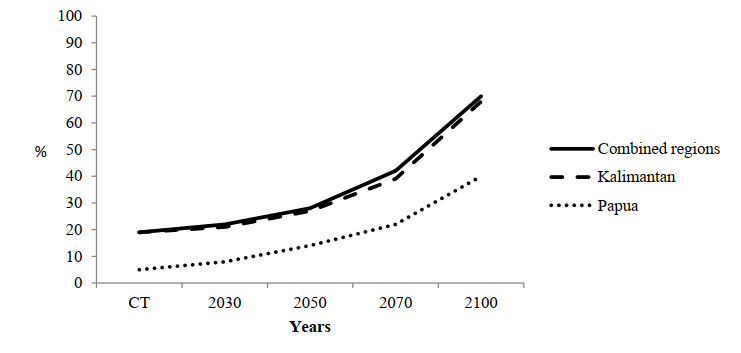









 DownLoad:
DownLoad:

